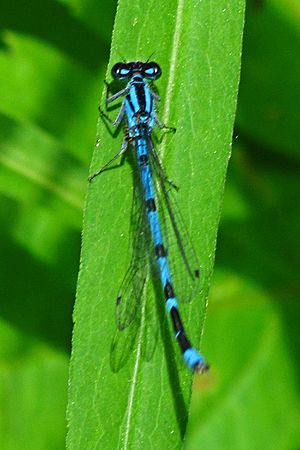Northern bluet facts for kids
Quick facts for kids Northern bluet |
|
|---|---|
 |
|
| Male | |
| Scientific classification | |
| Kingdom: | |
| Phylum: | |
| Class: | |
| Order: | |
| Suborder: | |
| Family: | |
| Genus: |
Enallagma
|
| Species: |
E. annexum
|
| Binomial name | |
| Enallagma annexum (Hagen, 1861)
|
|
The northern bluet (Enallagma annexum) is a type of small, colorful insect called a damselfly. Damselflies are often confused with dragonflies, but they are usually smaller and hold their wings differently when resting. The northern bluet belongs to a group of damselflies known as the bluets. It was once thought to be the same as another damselfly, the common bluet, but scientists now know they are different species.
What Does the Northern Bluet Look Like?
The northern bluet is a small damselfly. It grows to be about 1 to 1.6 inches (26 to 40 millimeters) long. That's about the length of your thumb!
The male northern bluet is mostly blue. You will see blue on the sides of its body (thorax). Its upper body (abdomen) is also blue. The parts at the end of its abdomen are longer on the bottom than on the top.
The female northern bluet looks a bit different. Her body is usually greenish-yellow or brown. The top part of her abdomen is mostly black.
When Can You See Them?
Northern bluets have a specific time of year when they fly around. You can usually spot them from early May to July. This is their "flight season."
Who Are Its Look-Alikes?
Many damselflies in the Enallagma group look very similar to each other. The northern bluet can be hard to tell apart from other "bluet" species. These include the boreal bluet, familiar bluet, Hagen's bluet, marsh bluet, and vernal bluet.
Here are some ways to tell them apart:
- You can tell the northern bluet from the familiar bluet by looking at the large spots behind its eyes. Also, the northern bluet has shorter parts at the end of its abdomen (called cerci).
- Northern bluets and boreal bluets share some features. They both have large spots behind their eyes. They also have a black spot on the second part of their abdomen (called S2) that looks like a mushroom. This spot is best seen from above.

